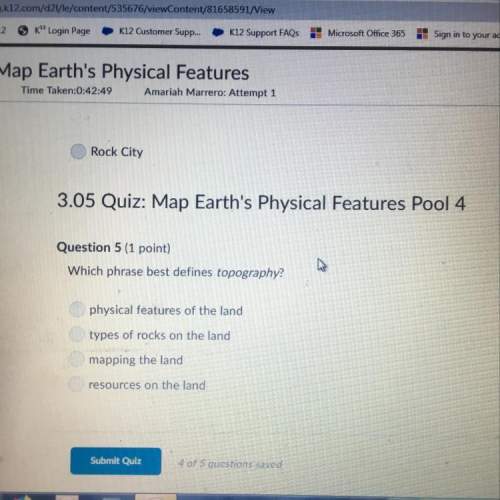
Chemistry, 05.11.2020 19:10 karlaperez7309
Standardization of an NaOH Solution
Experiment 1: Standardize an NaOH Solution Using Benzoic Acid as Primary Standard
Part 1: Prepare the NaOH Solution.
How many mL of water were used to prepare the NaOH solution?
200 mL
Data Analysis
Calculate the molarity of the NaOH solution. The molar mass of NaOH is 39.997 g/mol.
0.800g/39.99=0.0200015 moles
0.020 mol /0.200 L= 0.1M
Calculate the amount of benzoic acid to be neutralized by 20.00 mL NaOH solution, in both moles and grams. The molar mass of benzoic acid is 122.12 g/mol.
0.244 g
Part 2: Perform a Coarse Titration
Record the following data from your course titration in the table below.
mass of benzoic acid used (g) 0.244 g
pH of benzoic acid solution before titration 2.96
volume of NaOH in the burette before titration (mL) 50 mL
volume of NaOH in the burette after titration (mL) 17.86 mL
volume of NaOH dispensed in the titration (mL) 21.16 mL
Data Analysis
How do you expect your coarse titration volume to compare to your fine titration volumes?
Part 3: Perform Fine Titrations
Lab Results
Record the volume of NaOH solution dispensed in the 3 fine titrations.
20.05 mL, 20.05 mL, 19.95 mL
Data Analysis
Calculate the average concentration of the NaOH solution, using the average volume of NaOH solution dispensed in the 3 fine titrations.
(20.05+20.05+19.95)/3=20.02 mL
0.0200 mol/0.02002 L = 0.999 M
Experiment 2: Use the Standardized NaOH Solution to Determine the Concentration of an Acid
Part 1: Perform a Coarse Titration
Lab Results
What was the pH at the end point of the coarse titration?
11.25
Data Analysis
Based on your coarse titration volume, do you expect the acetic acid solution to have a higher or lower concentration than the NaOH solution?
Part 2: Perform Fine Titrations
Lab Results
For the 3 fine titrations of the acid of unknown concentration, fill in the following data.
Titration #1 Titration #2 Titration #3
volume of acid (mL) 34.05 mL 34.05 mL 34.05 mL
volume of NaOH dispensed (mL) 9.05 mL 9.05 mL 9.05 mL
Data Analysis
Calculate the following quantities and record the data in the table below.
average volume of NaOH solution dispensed (mL) 9.05 mL
average number of moles of NaOH dispensed 9.05 mL/39.997 = 0.226 mol
average concentration of the acid (mol/L) MaVa=MbVb
So: 0.226*9.05=2.05
2.05/25 mL = 0.082 mol/L
Conclusions
Phenolphthalein is pink over the range of pH 8 – 12. Why was it a useful indicator of when the equivalence point was reached?
It provides visual evidence for the equivalence point of the solution in which it is dispensed
Suppose a student titrated a sample of monoprotic acid of unknown concentration using a previously standardized solution of NaOH. Given the data in the figure below, what is the concentration of the unknown acid?
volume of 0.125 M NaOH dispensed 24.68 mL
volume of acid solution 50.00 mL
24.68/39.997=0.6170
0.6170*24.68= 15.23
15.23/50 = 0.3046

Answers: 1


Another question on Chemistry

Chemistry, 22.06.2019 01:30
Quickly! brainliest if two people answer! 1. the blood has red blood cells, white blood cells and platelets. red blood cells carry oxygen to other cells in the body. cells need oxygen to live. white blood cells destroy certain germs. they protect our bodies from disease. which question is answered in this paragraph? (a) what is the role of blood vessels? (b) what type of cells are attached to bones? (c) what type of blood cell to clot your blood? (d) what are the different types of blood cells? 2. which sentence from the section "stem cells" best explains the role of stem cells? (a) when one kind of cell stops working, stem cells can . (b) they can turn into that cell and take its place. (c) scientists are studying new ways to use stem cells. (d) these cells can people heal faster. 3. read the selection from the section "nerve cells." nerve cells send messages to the rest of our bodies. these messages move between the brain, spinal cord and various organs. nerve cells are also called neurons. fill in the blank. a "neuron" is a (a) cell that moves information from the brain to other parts of the body (b) stem cell that has both an axon and a dendrite (c) cell that controls the fingers of a body (d) cell that makes up the spinal cord 4. some muscles in our body move without us telling them to. these are called involuntary muscles. some examples are the cardiac muscle cells inside the heart. these cells the heart relax and fill with blood. what is the best definition of "involuntary" based on the context clues? (a) something that happens on its own (b) trying hard to do something (c) something moving back and forth (d) easily moved
Answers: 2


Chemistry, 22.06.2019 05:40
Fill in the coefficients that will balance the following reaction: a0cr2(so4)3 + a1agno3
Answers: 3

Chemistry, 22.06.2019 15:00
Why does a plastic bottle that is sealed at a high altitude change it’s shape when taken to lower altitude
Answers: 2
You know the right answer?
Standardization of an NaOH Solution
Experiment 1: Standardize an NaOH Solution Using Benzoic Acid a...
Questions

Spanish, 13.02.2021 07:40

Social Studies, 13.02.2021 07:40


World Languages, 13.02.2021 07:40


Health, 13.02.2021 07:40





Chemistry, 13.02.2021 07:40

Medicine, 13.02.2021 07:40

Social Studies, 13.02.2021 07:40

Mathematics, 13.02.2021 07:40

Arts, 13.02.2021 07:40



Mathematics, 13.02.2021 07:40

Chemistry, 13.02.2021 07:40

Business, 13.02.2021 07:40




